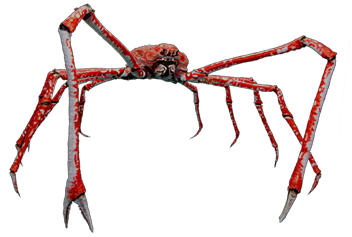japanese spider crab (macrocheira kaempferi)
The Japanese spider crab is the largest known arthropod; fully grown it can reach a leg span of almost 13 ft, a body size of up to 15 inches and a weight of up to 44 lb. The crab's natural habitat is on the bottom of the Pacific Ocean around Japan, where it feeds on dead animals and shellfish. It is believed to have a life expectancy of up to 100 years. The Japanese spider crab has 10 legs. The front two legs have been adapted into chelipeds, or claws. It has a dark orange body with white spots on its thin legs. In males, the limbs on which the claws are located become longer than its other limbs, and a large male can widen them to more than 10ft. The oval-shaped and vertically rounded shell can reach 12 in. in width and can be up to 16 in. long. The compound eyes are situated on the front, and two thorns stick out between them. Younger specimens feature hair and thorns on the shell, and their frontal horns are longer, but these gradually atrophy as the crab ages. The Japanese spider crabs' habitat is limited to the Pacific side of the Japanese archipelago. They often live on the seabed at depths of 500 ft to 2600 ft, but are found most prominently in depths of 650 to 1000 ft. In spring, they can often be found laying eggs in waters as shallow as 160 ft.

